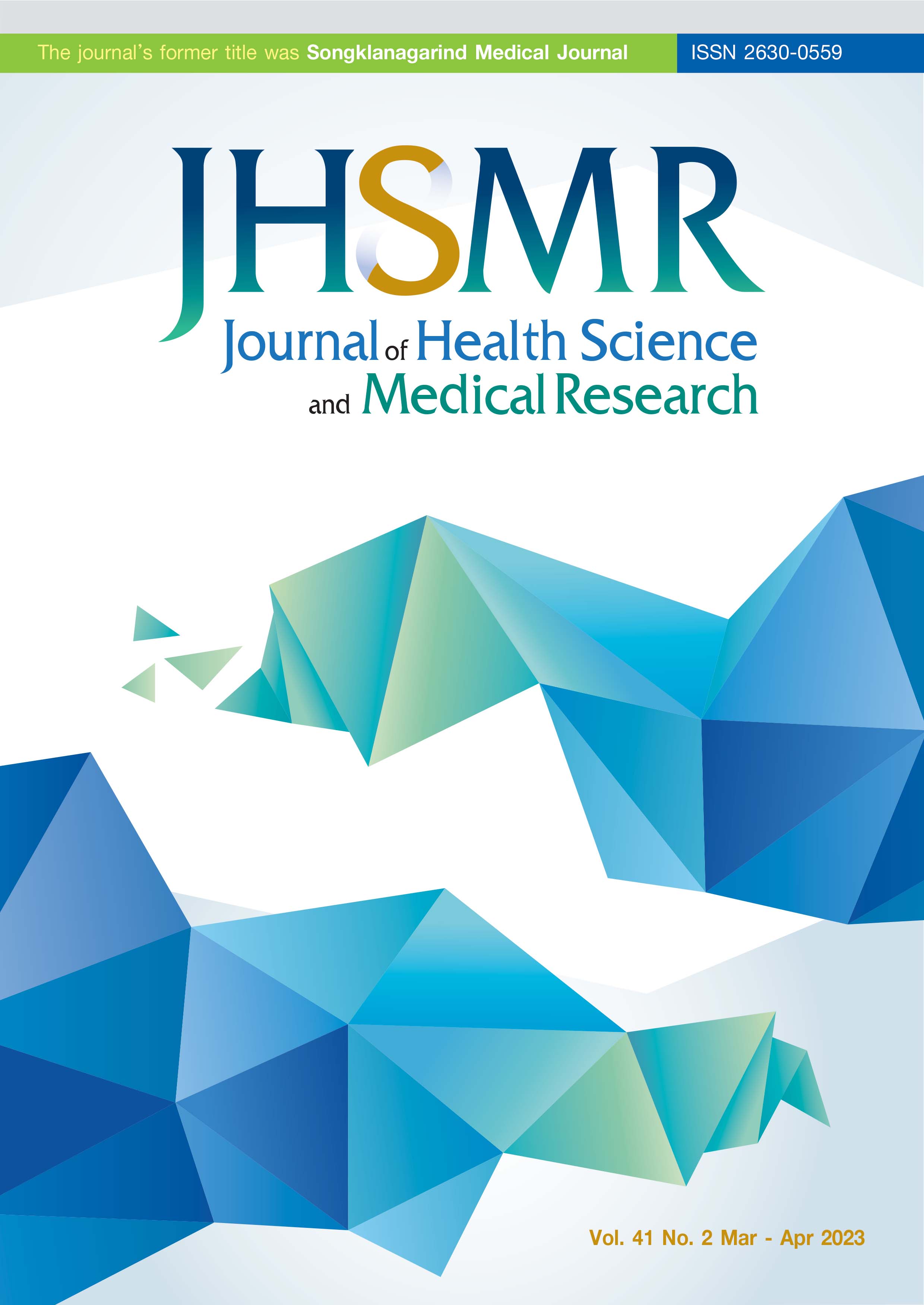The Effect of Polybrene on an aPTT-based Lupus Anticoagulant Test in the Plasma of Patients Receiving Unfractionated Heparin
DOI:
https://doi.org/10.31584/jhsmr.2022913Keywords:
aPTT, lupus anticoagulant, neutralization, polybrene, unfractionated heparinAbstract
Objective: Heparins can interfere with lupus anticoagulant (LA) testing, especially when the detection assays do not contain a heparin neutralizer. In this study we evaluated whether hexadimethrine bromide commonly known as polybrene was able to neutralize the effects of unfractionated heparin (UFH) on activated partial thromboplastin time (aPTT)-based LA determination.
Material and Methods: The influence of polybrene on the aPTT-based LA testing results of 14 patients receiving UFH therapy was studied. Measurements were performed using Dade Actin FSL (aPTT-LA screen) and Dade Actin FS (aPTT-LA confirm) reagents on a Sysmex CS-1600 analyzer. The aPTT-LA screen/confirm ratios before and after the polybrene treatments were compared.
Results: The UFH treatment affected the aPTT-LA screen/confirm ratio in four patterns, 1) no coagulation (NC code), 2) false positive, 3) false low, and 4) unchanged interpretation. After adding polybrene in the patient plasmas, the aPTT-LA screen/confirm ratios returned nearly to baseline without false positive or negative results.
Conclusion: The best practice for LA testing should be done outside anticoagulant therapies, but if necessary, the tests can be performed by adding the proper concentration of polybrene.
References
Kojima T. Targeted gene disruption of natural anticoagulant proteins in mice. Int J Hematol 2002;76(Suppl 2):36-9.
Langdown J, Johnson DJ, Baglin TP, Huntington JA. Allosteric activation of antithrombin critically depends upon hinge region extension. J Biol Chem 2004;279:47288-97.
Valenstein PN, Walsh MK, Meier F, College of American Pathologists. Heparin monitoring and patient safety: a College of American Pathologists Q-Probes study of 3431 patients at 140 institutions. Arch Pathol Lab Med 2004;128:397-402.
Basu D, Gallus A, Hirsh J, Cade J. A prospective study of the value of monitoring heparin treatment with the activated partial thromboplastin time. N Engl J Med 1972;287:324-7.
Coene KLM, van der Graaf F, van de Kerkhof D. Protocolled redefinition of the therapeutic range for unfractionated heparin: lost in translation? Clin Appl Thromb Hemost 2018;24:164-71.
Smythe MA, Priziola J, Dobesh PP, Wirth D, Cuker A, Wittkowsky AK. Guidance for the practical management of the heparin anticoagulants in the treatment of venous thromboembolism. J Thromb Thrombolysis 2016;41:165-86.
Levine MN, Hirsh J, Gent M, Turpie AG, Cruickshank M, Weitz J, et al. A randomized trial comparing activated thromboplastin time with heparin assay in patients with acute venous thromboembolism requiring large daily doses of heparin. Arch Intern Med 1994;154:49-56.
Olson JD, Arkin CF, Brandt JT, Cunningham MT, Giles A, Koepke JA, et al. College of American Pathologists Conference XXXI on laboratory monitoring of anticoagulant therapy: laboratory monitoring of unfractionated heparin therapy. Arch Pathol Lab Med 1998;122:782-98.
Moore GW. Recent guidelines and recommendations for laboratory detection of lupus anticoagulants. Semin Thromb Hemost 2014;40:163-71.
Moore GW. Commonalities and contrasts in recent guidelines for lupus anticoagulant detection. Int J Lab Hematol 2014; 36:364-73.
Devreese KMJ, de Groot PG, de Laat B, Erkan D, Favaloro EJ, Mackie I, et al. Guidance from the Scientific and Standardization Committee for lupus anticoagulant/antiphospholipid antibodies of the International Society on Thrombosis and Haemostasis: Update of the guidelines for lupus anticoagulant detection and interpretation. J Thromb Haemost 2020;18:2828-39.
Keeling D, Mackie I, Moore GW, Greer IA, Greaves M, British Committee for Standards in Hematology. Guidelines on the investigation and management of antiphospholipid syndrome. Br J Haematol 2012;157:47-58.
CLSI. Laboratory Testing for the Lupus Anticoagulant; Approved Guideline. CLSI document H60-A. Wayne, PA: Clinical and Laboratory Standards Institute; 2014.
Sangle NA, Rodgers GM, Smock KJ. Prevalence of heparin in samples submitted for lupus anticoagulant testing. Lab Hematol 2011;17:6-11.
Galli M, Finazzi G, Bevers EM, Barbui T. Kaolin clotting time and dilute Russell’s viper venom time distinguish between prothrombin-dependent and beta 2-glycoprotein I-dependent antiphospholipid antibodies. Blood 1995;86:617-23.
Grann VR, Homewood K, Golden W. Polybrene neutralization as a rapid means of monitoring blood heparin levels. Am J Clin Pathol 1972;58:26-32.
Kikura M, Lee MK, Levy JH. Heparin neutralization with methylene blue, hexadimethrine, or vancomycin after cardiopulmonary bypass. Anesth Analg 1996;83:223-7.
Godal HC. A comparison of two heparin-neutralizing agents: protamine and polybrene. Scand J Clin Lab Invest 1960;12:446- 57.
Tientadakul P, Kongkan C, Chinswangwatanakul W. Use of an automated coagulation analyzer to perform heparin neutralization with polybrene in blood samples for routine coagulation testing: practical, rapid, and inexpensive. Arch Pathol Lab Med 2013;137:1641-7.
Opartkiattikul N, Tientadakul P, Wongtiraporn W. Evaluation of the activated partial thromboplastin time (aPTT) sensitivity to unfractionated heparin using three commercial reagents: implication for therapeutic range. Siriraj Med J 2005;57:536-9.
Lawrie AS, Kitchen S, Efthymiou M, Mackie IJ, Machin SJ. Determination of APTT factor sensitivity-the misguiding guideline. Int J Lab Hematol 2014;35:652–7.
Jacobsen EM, Trettenes EJ, Wisløff F, Abildgaard U. Detection and quantification of lupus anticoagulants in plasma from heparin treated patients, using addition of polybrene. Thromb J 2006;4. doi: 10.1186/1477-9560-4-3.
Cumming AM, Jones GR, Wensley RT, Cundall RB: In vitro neutralization of heparin in plasma prior to the activated partial thromboplastin time test: an assessment of four heparin antagonists and two anion exchange resins. Thromb Res 1986,41:43-56.
Antovic A, Norberg EM, Berndtsson M, Rasmuson A, Malmström RE, Skeppholm M, et al. Effects of direct oral anticoagulants on lupus anticoagulant assays in a real-life setting. Thromb Haemost 2017;117:1700-4.
De Kesel PMM, Devreese KMJ. The effect of unfractionated heparin, enoxaparin, and danaparoid on lupus anticoagulant testing: Can activated carbon eliminate false-positive results? Res Pract Thromb Haemost 2020;4:161-8.
Downloads
Published
How to Cite
Issue
Section
License

This work is licensed under a Creative Commons Attribution-NonCommercial-NoDerivatives 4.0 International License.
























